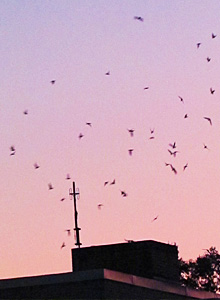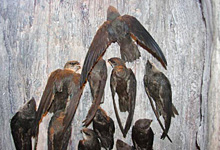
Chimney Swifts
Don’t look for Chimney Swifts in the winter, because it wouldn’t do you much good. But Wake Audubon’s 2011 Bird of the Year is the Chimney Swift (Chaetura pelagica). During winter this bird abandons the skies of eastern North America to spend its days coursing the air above the Amazonian rainforest. But come early April the Chimney Swift will once again sweep through the skies above our neighborhoods gleaning insects on the wing. Swifts are in a Family of birds called Apodidae, which roughly translates to “without feet.” Of course swifts do have feet, but the capabilities of their feet are limited. Chimney Swifts cannot perch, cannot walk, cannot hop- their feet are designed for clinging to a vertical surface. The genus Chaetura are known as the “spine-tailed” swifts. This name describes how the rachis or shaft of the tail feather extends beyond the vane or plume of the feather, and thus forms little pointed tips upon which the resting swift can brace itself while clinging to its perch. Before the arrival of European colonists Chimney Swifts nested and roosted in large hollow trees. In 1682 a swift was founding nesting for the first time in a chimney at a colonist’s cabin in Maine. This event forever changed the relationship between this species and people. Over the course of this year we’ll introduce you to more of the natural history and lore that swirls around this intriguing species.
Chimney Swifts in Summer – “Where there’s room in the hearth: Turn your chimney into a birdhouse for chimney swifts!”

Chimney Swifts roosting
Chimney Swifts in Autumn – By the end of July most Chimney Swifts have completed their nesting and their young are flying. They remain together as a family but often join other swifts in large feeding flocks at sites with large numbers of flying insects- agricultural fields and meadows, over ponds and lakes with large populations of emerging midges, and on the leading edge of thunderheads where they scoop up insects caught in the thermals. As dusk approaches these flocks drift back to the urban areas and instead of returning to their nesting chimneys, the flocking birds choose to roost together in large urban chimneys- those found at warehouses, factories or schools. This is an age-old phenomenon. John James Audubon described swifts entering a roost in a large sycamore tree near Louisville, Kentucky in 1808. By 1905, however, when John Burroughs described a roost of 10,000 swifts near Boston, the birds had adopted chimneys. He wrote, “after a great many feints and playful approaches a streamful of them, as if drawn by some power of suction, would pour into the opening…then as if in the spirit of frolic had again got the upper hand of them, the ring would rise, and the chippering and circling go on. In a minute or two the same maneuver would be repeated, the chimney as it were, taking its swallows at intervals to prevent choking.” Roosts grow larger as late summer drifts into fall. This is because swifts migrating south join flocks of local birds that have not yet migrated. In our area, swift numbers peak in September when roosts of 5000 birds can be found. Most swifts leave North Carolina by the first week in October. This tendency to roost launched the largest all-volunteer effort to study the migratory path of a species of bird that was ever undertaken. During a 22-year period that began in 1934, over 550,000 swifts were captured and banded at roost sites, many of which were in Tennessee. These citizen researchers would identify occupied roost chimneys and set a cage over the chimney opening at night. When the swifts arose in the morning they would be captured and banded as they emerged from their roost. Ultimately, 13 bands were recovered from the wintering grounds in Peru; this the result of Amazonian Indians smoking birds from a hollow tree to eat them, only to find these odd metal bands on their legs. The Indians brought the bands to the Jesuit mission. That’s how we discovered the wintering grounds. It’s one of the most remarkable stories in the annals of scientific inquiry.
September is an exciting time to view our bird of the year here in Wake County. Chimney Swifts roost in large chimneys as they meet up and migrate south for the winter. Although many of their roosting chimneys are gone, the NC Museum of Natural Sciences folks were able to film Chimney Swifts circling over downtown Raleigh and entering the large chimney of the Commerce Building. Click here to view. Wake Audubon leads walks every Sunday evening in September to view this awesome sight. Join us. Check the calendar on the main page.
Many of the large chimneys that swifts use for roosting are being lost, even in our area. Schools were a favorite choice but renovations of aging HVAC systems have removed or otherwise made chimneys unavailable. There seem to be fewer than 20-30 large roost chimneys remaining in the Raleigh-Cary area and we are losing a few each year. Wake Audubon is partnering with the NC Museum of Natural Sciences to install a permanent Chimney Swift Roost Tower at the Museum’s Prairie Ridge facility. This Roost Tower will provide researchers with the opportunity to conduct research on roosting, and will also provide a viewing area for the public to enjoy this annual spectacle. We are collecting donations through our Buy a Brick for Swifts campaign – learn how you can “buy a brick” with a personalized description to show your lasting support.
Bird of the Year Index